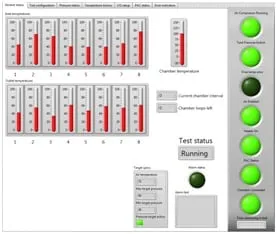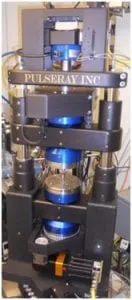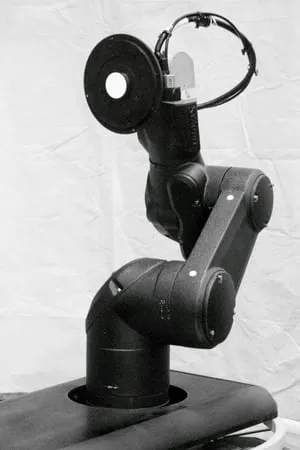NI / LabVIEW Systems
DSM is a National Instruments (NI) Alliance Partner with a Certified LabVIEW Developer (CLD) on staff. We have the staff and experience to offer services ranging from troubleshooting existing NI / LabVIEW systems to designing and building complete new ones. Project examples below.

WHAT WE OFFER
- Scope Definition
- High Level Planning
- Hardware Recommendations
- Software Implementation
- Troubleshooting
- Documentation
- Continued Support
- System Integration
APPLICATIONS
- Motion Control
- Custom GUIs
- Data Aquisition
- FPGA-based cRIO
- Signal Generation
- Robotics
- Hardware Integration
- Close Loop Control
- Single-board RIO
- Test Automation
SERVICES INCLUDE
- PC-based analog and digital signal generation, data capture, and signal analysis
- Distributed control and automation (motion control software solutions)
- National Instruments DAQmx and CompactDAQ-based hardware solutions
- Automated testing control spanning seconds, days, or weeks
- High-speed programming running on NIís FPGA-based compactRIO (cRIO) and single-board RIO (sbRIO) platforms, including a custom NI SoftMotion-based closed-loop piezoelectric actuator controller
Project Examples

AUTOMOTIVE ENGINE PART TESTER
DSM contracted with Hutchinson FTS to develop a data acquisition and supervisory control program in LabVIEW for an apparatus used to test engine components. Hutchinson specified commercial off-the-shelf (COTS) components, designed application-specific hardware, and built the mechanical assembly. DSM designed a program used coordinate data acquisition and remote supervision of a 3-axis motion controller, a thermal chamber, heaters, thermocouples, pressure transducers, and other hardware which would simulate an automotive engine environment. DSM worked closely with Hutchinson FTS to deploy and debug the software on-site within 3 weeks of receipt of order.

TENSILE TESTER CONTROL PROGRAM
Working with PulseRay Inc., DSM provided consulting services on software for control of a highly specialized tensile test machine that is installed at the Cornell High Energy Synchrotron Source (CHESS). This system is able to record high resolution x-ray imagery of test specimens of aerospace alloys while they are subjected to tensile and cyclic fatigue tests. This capability will improve our understanding of how grain refinement can be used to enhance material properties. The tensile tester is able to function in multiple modes of operation, including closed-loop position and force control. The sample can be rotated 360 degrees within the tester, permitting three-dimensional imagery of samples using computed tomography. In addition to programming support related to motion control, DSM also provided specialized actuators that were incorporated into the load frame.

AUTOMATED CRYOGENIC TEST STATION
A test station was built to automate cyclic cryogenic exposure. A LabVIEW program was implemented to automate the process and collect data. The software featured:
- Monitored the temperature of up to 8 thermocouples
- Monitored the life status of test specimens twice per cycle
- Automated backups to allow for data recovery in the even of a system failure
- Temperature plots, status indicators, test logs
- System was integrated with a pneumatic control board and safety features

STÄUBLI LABVIEW INTEGRATION LIBRARY
The DSM LabVIEW-Stäubli Control Library is designed to facilitate communications between a host PC running LabVIEW and a Stäubli robotic motion controller in order to control the robot from the LabVIEW environment.
Typically, robots of the type supplied by Stäubli are found in the automation industry. The standard Stäubli programming language, VAL3, is a flexible language allowing for a wide variety of tasking. While the VAL3 language works well in its intended environment, there are limited options for connecting the robot to an existing PC-based test & measurement system. The LabVIEW language, on the other hand, has been designed from the ground up to run systems found in a research environment. The DSM LabVIEW-Stäubli Integration Library allows the user to quickly develop applications for a Stäubli robot using the familiar LabVIEW programming language.
DYNAMOMETER TEST STATION
DSM built a test station designed to characterize piezoelectric motors. A programmable current source and a DC motor were integrated into the system to apply a range of resistive torque loads to the motor being tested. A torque load cell and a high-resolution encoder were used to measure torque and speed, which could be collected at each resistive torque level, forming a torque curve. A LabVIEW project was programmed to run the test. Test settings were configured in the program and data was collected by an NI DAQ card. The program also included data manipulation and analysis, so the program reported exactly the information that the user needed.
OPEN-LOOP ACTUATOR CONTROLLER
A controller was required to perform open-loop control testing. The goal was to characterize an actuator's open-loop performance to develop a closed-loop control scheme. This program was capable of outputting voltage waveforms as well as voltage steps up to 40V. Voltage duration was programmable down to the millisecond. An integrated encoder reported position data in real-time. The encoder featured resolution on a micron level. Though system vibrations generated exceptional noise, the data was able to be filtered after the test to report accurate, low-noise data.
